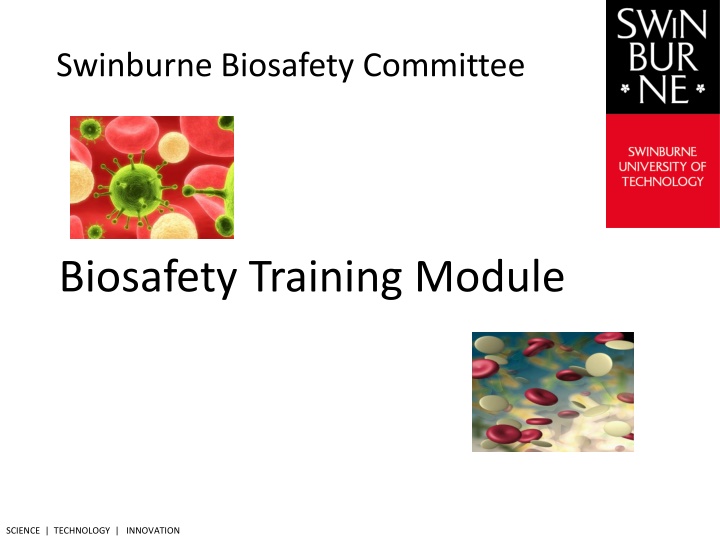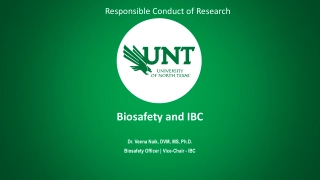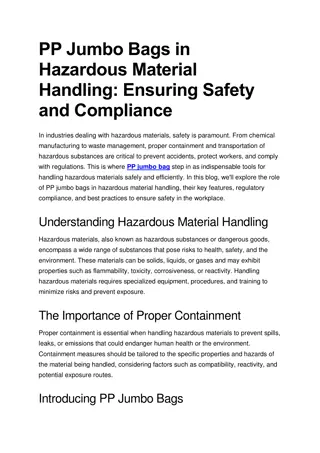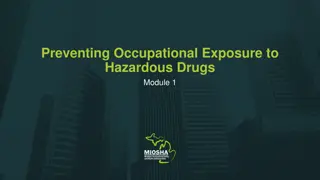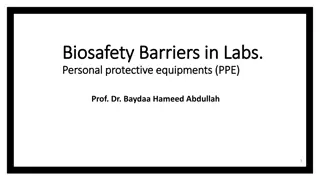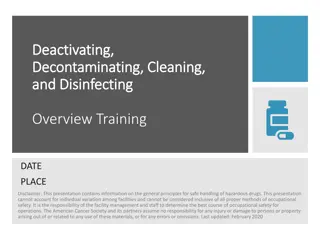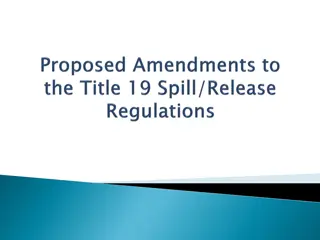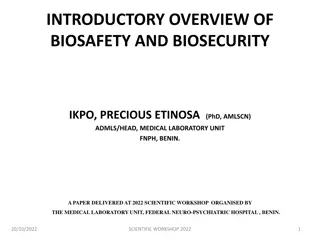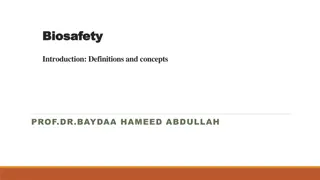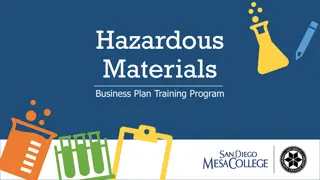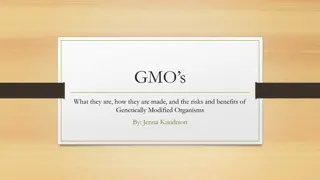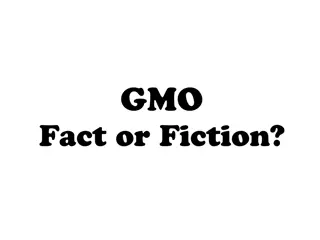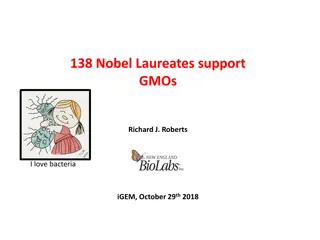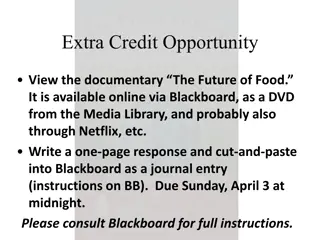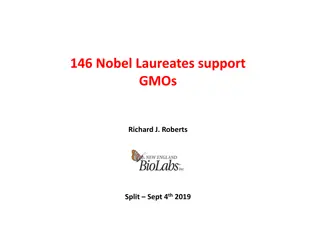Biosafety Training Module for GMOs and Hazardous Materials
The Swinburne Biosafety Committee oversees activities involving genetically modified organisms (GMOs) and biohazardous materials, ensuring compliance with safety regulations. Topics covered include modes of disease transmission, standard precautions, and biological safety cabinets. Understanding transmission pathways and implementing standard precautions are essential for safe handling of hazardous biological agents.
Download Presentation

Please find below an Image/Link to download the presentation.
The content on the website is provided AS IS for your information and personal use only. It may not be sold, licensed, or shared on other websites without obtaining consent from the author.If you encounter any issues during the download, it is possible that the publisher has removed the file from their server.
You are allowed to download the files provided on this website for personal or commercial use, subject to the condition that they are used lawfully. All files are the property of their respective owners.
The content on the website is provided AS IS for your information and personal use only. It may not be sold, licensed, or shared on other websites without obtaining consent from the author.
E N D
Presentation Transcript
Swinburne Biosafety Committee Presentation title Biosafety Training Module SCIENCE | TECHNOLOGY | INNOVATION
Swinburne Biosafety Committee (SBC) The SBC is responsible for reviewing and approving Swinburne activity (research and teaching) or facilities involving: Genetically Modified Organisms (GMOs) Biohazardous materials/hazardous biological agents SCIENCE | TECHNOLOGY | INNOVATION
Swinburne Biosafety Committee You will need SBC approval for matters involving GMOs & certification of physical containment facilities in which GMO dealings will be conducted Organisms in Risk Group 2, 3 or 4 (AS/NZS 2243.3:2010) or procedures that may result in the isolation or enrichment of such organisms All human tissue or blood products Cultured primary mammalian cells or mammalian cell lines likely to contain infectious agents Material of biological origin that may be or may contain a hazard to humans e.g. toxins, allergens, prions Security Sensitive Biological Agents (SSBAs) Quarantine materials in any of the above categories SCIENCE | TECHNOLOGY | INNOVATION
Topics to be covered Presentation title Genetically Modified Organisms (GMOs) Biologically hazardous microorganisms SCIENCE | TECHNOLOGY | INNOVATION
Microorganisms Topics: modes of disease transmission standard precautions biological safety cabinets spill & waste management SCIENCE | TECHNOLOGY | INNOVATION
Transmission Escape from the host or reservoir of infection Transport to the new host via ingestion, inhalation or skin penetration Entry to the new host SCIENCE | TECHNOLOGY | INNOVATION
Standard precautions personal hygiene practices, particularly handwashing use of personal protective equipment (gloves, gowns and protective eyewear) use of 70% alcohol-based chlorhexidine (0.5%) hand rub solutions as an adjunct to hand washing appropriate handling and disposal of sharps and other infectious waste adequate sterilisation of reusable equipment environmental controls, including design and maintenance of premises SCIENCE | TECHNOLOGY | INNOVATION
Biological safety cabinets Biological safety cabinets (BSC) are used when working with specimens containing micro-organisms transmissible by the respiratory route or when work produces a significant risk from aerosol production. Class I Class II Class III exhaust-ventilated, protection is afforded by an inward flow of air away from the user and a HEPA (high efficiency particulate air) filter is used before exhaust air is discharged from the cabinet completely enclosed unit and the user is physically separated from the work. Both incoming and outgoing air passes via HEPA filters. This class of safety cabinet is used for work with high-hazard micro-organisms provide protection by inducing an inflow of room air through the work access opening, by passing recirculated, HEPA-filtered, laminar flow air over the work zone to prevent it becoming contaminated. A HEPA filter is used before exhaust air is discharged from the cabinet. * Bunsen burners should not be used in Class II cabinets as they disrupt the laminar flow and the barrier air. * Laminar flow benches must never be used when handling pathogenic materials as any aerosols formed will be directed at the user. SCIENCE | TECHNOLOGY | INNOVATION
Spills & waste management Spills PC2 facility Biosafety cabinets risk assessment determine the hazard level & identify the proper clean-up procedure small and contained aerosols removed *All spills must be reported. Waste Dispose of carefully Decontaminate SCIENCE | TECHNOLOGY | INNOVATION
Microorganisms AS/NZS 2243.3:2010 Safety in laboratories Part 3: Microbiological safety and containment classifies microorganisms into four risk groups and specifies work requirements for the corresponding four physical containment levels The basic approach to working with microorganisms is to regard them as potential pathogens and to handle them with standard microbiological techniques PC labs according to AS/NZS 2243.3:2010 are not the same as OGTR-certified PC labs so please ensure you know which you are referring. SCIENCE | TECHNOLOGY | INNOVATION
Microorganisms Risk Group categories Risk Group 2 (moderate individual risk, limited community risk) unlikely to be a significant risk to laboratory workers, the community, livestock, or the environment; laboratory exposures may cause infection, but effective treatment and preventive measures are available, and the risk of spread is limited. Risk Group 3 (high individual risk, limited to moderate community risk) usually causes serious human or animal disease and may present a significant risk to laboratory workers. It could present a limited to moderate risk if spread in the community or the environment, but there are usually effective preventive measures or treatment available. Risk Group 4 (high individual and community risk) usually produces life-threatening human or animal disease, represents a significant risk to laboratory workers and may be readily transmissible from one individual to another. Effective treatment and preventive measures are not usually available. Risk Group 1 (low individual and community risk) unlikely to cause human or animal disease. SCIENCE | TECHNOLOGY | INNOVATION
Microorganisms Risk Group 1 Risk Group 2 Risk Group 3 Risk Group 4 PC1 PC2 PC3 PC4 Human and animal clinical and diagnostic specimens would normally be regarded as Risk Group 2 and shall be handled in PC2 facilities unless a higher risk group is indicated by the clinical notes. SCIENCE | TECHNOLOGY | INNOVATION
Microorganisms Persons who are immuno-suppressed, immuno-compromised, or vulnerable to infection, should inform their supervisor or laboratory manager of their condition so that appropriate action may be taken. Some important points: All female employees should be warned of the risk to the unborn child or the pregnant woman of occupational exposure to certain microorganisms, e.g., Listeria monocytogenes, rubella virus, human immunodeficiency virus (HIV), hepatitis B, C and E viruses. SCIENCE | TECHNOLOGY | INNOVATION
Microorganisms Examples of Risk Group 2 parasites Examples of Risk Group 2 bacteria SCIENCE | TECHNOLOGY | INNOVATION (reproduced from AS/NZS 2243.3:2010)
Microorganisms Examples of Risk Group 4 viruses Examples of Risk Group 3 viruses SCIENCE | TECHNOLOGY | INNOVATION
Genetically Modified Organisms Definition Legislation GMOs at Swinburne - handling - storage - containment SCIENCE | TECHNOLOGY | INNOVATION
Definition: What is a GMO? An organism that has inherited traits from an organism that occurred in the initial organism because of GT* An organism that has been modified by GT* *GT (Gene Technology) any technique for the modification of genes or other genetic material, but does not include: sexual reproduction homologous recombination any other technique specified in the regulations. SCIENCE | TECHNOLOGY | INNOVATION
What is not a GMO? Fusion of animal cells (unless the product can form an animal) Naturally occurring mutations Plants formed by protoplast fusion, embryo rescue or in vitro fertilisation or zygote implantation Organisms formed by natural DNA transfer (reproduced and modified with permission from Curtin University Health and Safety) SCIENCE | TECHNOLOGY | INNOVATION
GMO Regulation Gene Technology Regulations 2001 Gene Technology (GT) Act 2000 Federal Administration via the Office of the Gene Technology Regulator (OGTR) States have mirror regulations Regulations reviewed and updated regularly SCIENCE | TECHNOLOGY | INNOVATION
Object of the GT Act (2000) to protect the health and safety of people and the environment: by identifying risks posed by or as a result of gene technology, and by managing those risks through regulating certain dealings with GMOs. SCIENCE | TECHNOLOGY | INNOVATION
Role of the Office of the Gene Technology Regulator (OGTR) Accreditation of organisations Certification of facilities Certification of dealings Ensures that sufficient oversight is in place Institutional Biosafety Committee (IBC)* Ensures conditions necessary to minimise risk are maintained Ensures that GMO dealings are undertaken safely, in appropriate facilities, considers ethics and ensures there is a record Ensures researchers are appropriately trained/responsible At Swinburne, IBC = Swinburne Biosafety Committee SCIENCE | TECHNOLOGY | INNOVATION
What is a GMO dealing? conduct experiments with the GMO make, develop, produce or manufacture the GMO breed the GMO propagate the GMO use the GMO in the course of manufacture of a thing that is not a GMO grow, raise or culture the GMO import the GMO transport the GMO dispose of the GMO includes the possession, supply or use of the GMO for the purposes of, or in the course of, a dealing mentioned above Defined in the regulations SCIENCE | TECHNOLOGY | INNOVATION
Types of Dealings Dealings not involving release (DNIRs) - Medium risk, mostly due to potential for harm (to people or environment) from unintentional release allows the OGTR to impose conditions to manage risk Notifiable low risk dealings (NLRDs) Low risk as long as certain conditions are adhered to. Dealings involving release (DIRs) Exempt dealings Low risk, negligible consequences from release Emergency Dealing Determination (EDD) High risk SCIENCE | TECHNOLOGY | INNOVATION
Regulating GMO dealings Regulations Regulations Regulations contain detailed Schedules Schedules define the category to which a dealing belongs SCIENCE | TECHNOLOGY | INNOVATION
Schedules Schedule 1A: Techniques that are not GT Schedule 1: Organisms that are not GM Schedule 2: Dealings exempt from licensing Part 1 Exempt dealings Part 2 Host/vector systems for exempt dealings Part 3 Definitions Schedule 3: NLRDs in relation to a GMO Part 1 NLRDs suitable for at least PC1 containment Part 2 NLRDs suitable for at least PC2 or PC3 containment Part 3 Dealings that are not NLRDs SCIENCE | TECHNOLOGY | INNOVATION
Physical Containment (PC) facilities The OGTR has adopted the four-tier classification system based on AS/NZS 2243.3 for certifying facilities suitable for GMO dealings PC1 PC2 PC3 PC4
Physical Containment (PC) facilities Dealings must be conducted in a facility certified by the OGTR at a level appropriate to the potential risk posed by the dealing. Exempt not necessary, but recommend PC1 PC2 DIR outside containment facilities NLRD PC1 PC3 DNIR PC2 PC4 NB: PC4 is not applicable in the Swinburne context.
Dealings at Swinburne Exempt NLRD DIR DNIR NB: DNIR not applicable in the Swinburne context NB: DIR not applicable in the Swinburne context. SCIENCE | TECHNOLOGY | INNOVATION
Exempt dealings (examples) Dealings using host/vectors from Schedule 2 e.g. E. coli/ non-conjugative plasmids GM C. elegans GM of the somatic cells of an animal Note: devil s in the detail read the fine print SCIENCE | TECHNOLOGY | INNOVATION
Exempt dealings (at Swinburne) The Swinburne Biosafety Committee must be notified May be undertaken in a non-OGTR certified facility but recommend PC2 Maintain good laboratory practice GMOs should not be released into the environment Best practice SCIENCE | TECHNOLOGY | INNOVATION
NLRD - PC1 dealings (examples) GM mouse, rat, guinea pig, rabbit Replication defective adenoviral vectors Must not restore competence of the vector No genes that confer oncogenic modifications in humans No genes that encode proteins with immunomodulatory activity in humans SCIENCE | TECHNOLOGY | INNOVATION
NLRD PC2 dealings (examples) GM of whole animals (except mouse etc) GM of plants exempt host/vectors where the conditions for exempt status are not met Non-exempt host/vectors Volumes >25L Viral vectors (assorted subcategories) Note: devil s in the detail read the fine print! SCIENCE | TECHNOLOGY | INNOVATION
Working with NLRDs? You must Must have SBC approval BEFORE the dealing starts Must notify the OGTR (via SBC) Must be undertaken in OGTR certified PC2 labs Undertake OGTR PC2 training (see your Laboratory Manager) Observe Part C: Behavioural requirements Guidelines for Certification of a Physical Containment Level 2 Laboratory SCIENCE | TECHNOLOGY | INNOVATION
OGTR-Certified PC2 behavioural guidelines Access and Egress Restricted to authorised personnel All doors and windows must be closed Procedures must be in place to prevent cross contamination Non GMO Work that produces an aerosol must be performed in a Biological Safety Cabinet Aerosols SCIENCE | TECHNOLOGY | INNOVATION
PC2 behavioural guidelines Decontamination All decontamination procedures must be carried out by trained personnel. GMOs must be rendered non-viable prior to disposal. Wastes containing GMOs must be decontaminated prior to disposal. Work benches, surfaces and equipment must be decontaminated when the dealings are completed. Equipment must be decontaminated before being removed from the facility. SCIENCE | TECHNOLOGY | INNOVATION
PC2 behavioural guidelines Decontamination can be effected by Autoclave Chemical Bleach (5000ppm sodium hypochlorite = 0.5%) [Household bleach = 4% sodium hypochlorite 1/8 dilution = final concentration of 0.5% hypochlorite] Freshly prepared (same day) Do not autoclave bleach SCIENCE | TECHNOLOGY | INNOVATION
Transport Between laboratories, buildings, campuses Decontaminate (e.g. 80% ethanol spray) Double contained Sealed unbreakable containers Labelled Primary container prior to packing Secondary (outer) container prior to leaving the lab SCIENCE | TECHNOLOGY | INNOVATION
Spills If a spill occurs outside the facility: All spilt material must be recovered and contaminated surfaces decontaminated Any real or suspected unintentional release must be reported to the SBC and OGTR as soon as reasonably possible. SCIENCE | TECHNOLOGY | INNOVATION
Your responsibilities Everyone Chief Investigators/Project leaders Work safely Look after yourself and those around you Wear/use appropriate PPE Attend training sessions Keep accurate records of your GM work Know which regulations affect your work (and comply with them) Get approval for GM work from the Swinburne Biosafety Committee Ensure work is undertaken in an appropriately certified facility Ensure GM records are kept Ensure all people working with GMOs have appropriate training Ensure appropriate supervision is maintained Are responsible for staff and students working on project Provide annual reports SCIENCE | TECHNOLOGY | INNOVATION
Penalties defined in GT Act Breach of NLRDs Breach of GMO licence (DNIR/DIR) 50 penalty units ($5,500) Each day the breach occurs is considered a separate offence! Aggravated offence = significant damage to health and safety of people or the environment 5 years imprisonment or 2000 penalty units ($1.1 million) Other cases 2 years imprisonment or 500 penalty units ($55,000) SCIENCE | TECHNOLOGY | INNOVATION
Swinburne Biosafety Committee You will need SBC approval for matters involving the following, through the Research Integrity Office, prior to commencing. GMOs & certification of physical containment facilities in which GMO dealings will be conducted Organisms in Risk Group 2, 3 or 4 or procedures that may result in the isolation or enrichment of such organisms All human tissue or blood products Cultured primary mammalian cells or mammalian cell lines likely to contain infectious agents Material of biological origin that may be or may contain a hazard to humans e.g. toxins, allergens, prions Security Sensitive Biological Agents (SSBAs) Quarantine materials in any of the above categories SCIENCE | TECHNOLOGY | INNOVATION
Research Integrity Office Advice on regulatory and institutional requirements for the use of GMOs and biological hazardous materials. Secretariat support to the Swinburne Biosafety Committee (SBC) Third (after Supervisor and Lab Manager) point of contact for queries regarding applications to use GMOs and/or biological hazardous materials Contact details: Executive Officer, SBC Research Integrity Office Swinburne Research SCIENCE | TECHNOLOGY | INNOVATION
Regulating GMO dealings extra info Exempt Dealings - certain types of dealings with GMOs which involve a very low risk (i.e. contained research involving very well understood organisms and processes for creating and studying GMOs). Other then listing in the Regulations, the only legislative requirement for exempt dealings is that they must not involve an intentional release of a GMO into the environment. Notifiable Low Risk Dealings - the regulations also set out categories of dealings with GMOs which are low risk and which may proceed provided that certain conditions spelt out in the regulations are observed. This includes requirements that the specified dealings be undertaken only in certified contained facilities, overseen by Institutional Biosafety Committees (IBCs) and notified annually to the Regulator. The conditions under which such dealings must be conducted are clearly set out in the regulations. An NLRD must not involve the intentional release of a GMO into the environment. Licences - all dealings with GMOs (that are not exempt or NLRDs or on the GMO Register) need to be licensed by the Regulator. The licensing system is based on rigorous scientific risk assessment and extensive consultation with expert advisory committees, Government agencies and, for intentional releases of GMOs into the environment, the public. GMO Register - dealings with GMOs may be entered on the GMO Register once they have been licensed for a certain period of time. Dealings will not be entered onto the Register until the Regulator is satisfied that the dealings are sufficiently safe that they can be undertaken by anyone, and that safety does not depend on oversight by a licence holder. Emergency Dealing Determination (EDD) - the Minister may make an EDD authorising dealings with GMOs for a limited period in an emergency. The Minister must be satisfied that there is an actual or imminent threat to people or the environment, that the EDD would adequately address the threat and that risks posed are able to be managed so as to protect people and the environment. The Minister must receive advice from the Regulator to management of risks. SCIENCE | TECHNOLOGY | INNOVATION
